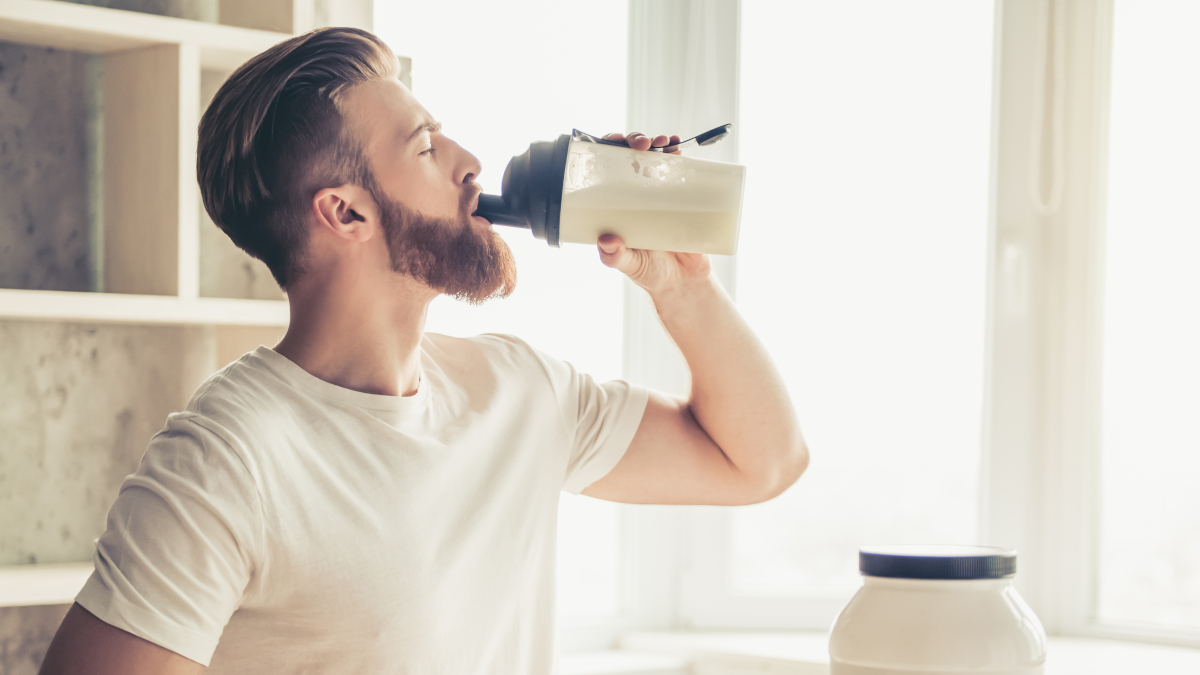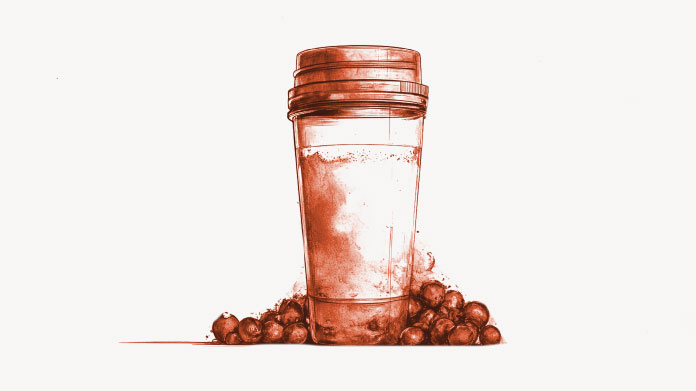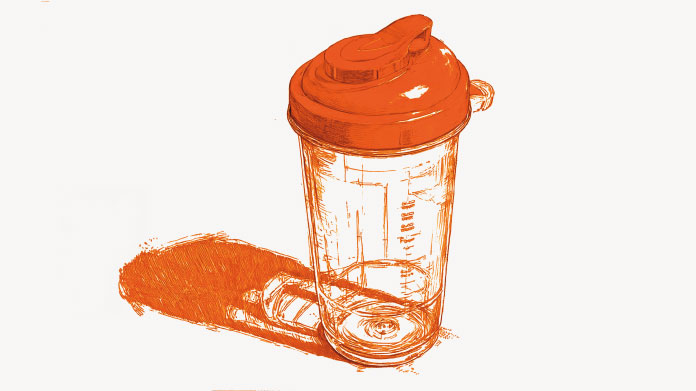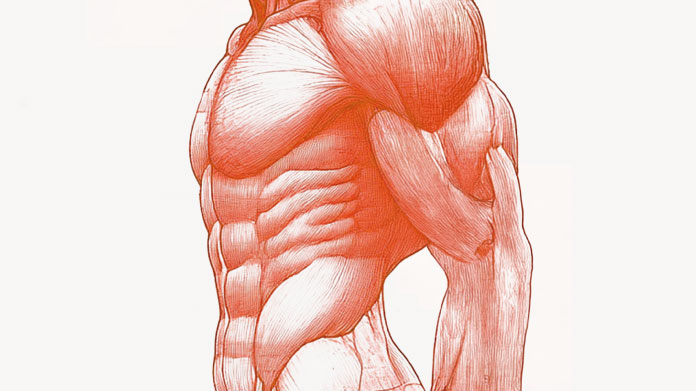Creatine: why, how and when should you take it?
Very popular with sportspeople and bodybuilders in particular, creatine has managed to develop a bad reputation … even though it’s perfectly safe! Discover creatine’s effects and the best way of benefiting from it.

What is creatine: definition
Discovered in the mid-19th century by a French scientist, creatine is a substance naturally produced by the liver, pancreas and kidneys from certain amino acids (glycine, arginine and methionine) found in food.
But this endogenous creatine accounts for only half the creatine in the body. The other, exogenous, half comes from the diet.
95% of the body’s creatine is stored in muscles. The rest is primarily deposited in the brain, and to a lesser degree, the heart, and in men, the testicles.
Some of the creatine in muscles is combined with phosphate, a reaction catalysed by creatine kinase, to produce phosphocreatine. This is used by cells, along with adenosine diphosphate (ADP), to produce adenosine triphosphate (ATP), the main energy source for cells (1-2).
Which foods contain creatine?
Meat and fish are the principal dietary sources of creatine. On average, for example:
- 1 kg of herring contains 10g;
- 1 kg of beef contains 4.5g;
- 1 kg of tuna contains 4g.
In contrast, plant-source foods contain almost no creatine. One study found much lower levels of creatine among vegetarians compared with omnivores (3).
This is hardly surprising. Even though endogenous creatine is produced from glycine, arginine and methionine (so it’s possible to boost your endogenous creatine production by prioritising foods rich in these amino acids), eating only plant-source foods means you are missing out on a significant amount of exogenous creatine from the diet.
What are creatine’s effects?
If creatine has for some time had a reputation as a doping product, and is even banned in certain countries, it’s because it helps to improve sports performance. Creatine does indeed increase physical performance, particularly in successive bursts of short-duration, high-intensity exercise (football, handball, tennis, cycling, weight-training, CrossFit, etc.).
But contrary to what some would have you believe, creatine does not increase muscle mass! Supplementing with creatine actually helps to increase the phosphocreatine in muscles, enabling muscle cells to restore their ATP reserves more quickly. . This allows creatine-users to engage in more intensive exercise sessions, especially body-building. And it’s this increased intensity which helps produce greater muscle mass.
In short: supplementing with creatine makes it possible to exercise more intensively which in turn helps you gain muscle.
What’s more, according to the European Food Safety Agency, daily creatine supplementation may maximise the effects of resistance training on muscle strength, particularly in those over 55 (4-6).
It’s worth noting that creatine supplementation leads to slight intramuscular fluid retention, meaning that creatine-users may appear less ‘skinny’ or ‘honed’. People who practise weight-training sometimes find their muscles look bigger simply as a result of supplementing with creatine:in fact, their muscles are ‘swollen’ with water (7).
How and when should you take creatine? What’s the right dose?
Creatine is not a magic potion which bestows instant dynamism: you shouldn’t expect to immediately have more energy available for exercising the minute you start taking it.
What supplementing with creatine does is to ‘saturate’ the muscles with phosphocreatine, so that muscle cells always have enough to produce ATP.
In addition, supplementing for between 1 and 3 weeks is generally believed to be necessary, depending on the individual, before the initial effects of creatine are felt. However, contrary to what some recommend, there is no need to take a ‘loading dose’ whereby you take a higher dose of creatine for the first week before adjusting to a ‘normal’ daily dose.
The best approach is to take 3g-5g of creatine a day, preferably with some carbohydrates (fruit is perfect), at any time of day (8).
Taking creatine supplements immediately after a training session is sometimes recommended though there are no studies to support such advice.
It’s therefore best to take creatine at the time of day that suits you best. If you’re worried you might forget, it’s probably easiest to take it at breakfast, or at lunch time if you’re doing intermittent fasting.
The best forms of creatine
While the most popular and widely-researched form of this substance, much-prized by sportspeople, is creatine monohydrate, there are many other forms which also offer advantages.
Some laboratories, for example, have recently developed a new form of creatine designed to maximise its effects: creatine pyruvate. This contains pyruvic acid which acts as a catalyst for ATP production (9).
You can also takecreatine phosphate direct, ie, as phosphocreatine. This way, you ‘skip’ a stage in the metabolism of creatine, thus making the phosphate more rapidly available to cells for the production of ATP.
So to gain maximum benefit from this compound, it makes sense to opt for a synergistic formulation combining creatine monohydrate, creatine pyruvate and phosphocreatine (such as 3-Creatine).
References
- SCHILLING, Brian K., STONE, MICHAEL H., UTTER, A. L. A. N., et al. Creatine supplementation and health variables: a retrospective study. Medicine and science in sports and exercise, 2001, vol. 33, no 2, p. 183-188.
- BROSNAN, John T., DA SILVA, Robin P., et BROSNAN, Margaret E. The metabolic burden of creatine synthesis. Amino acids, 2011, vol. 40, no 5, p. 1325-1331.
- Burke DG, Chilibeck PD, Parise G, Candow DG, Mahoney D, Tarnopolsky M., « Effect of creatine and weight training on muscle creatine and performance in vegetarians », Med Sci Sports Exerc, vol. 35, no 11, 2003, p. 1946-55
- KREIDER, Richard B. Effects of creatine supplementation on performance and training adaptations. Molecular and cellular biochemistry, 2003, vol. 244, no 1, p. 89-94.
- FRANCAUX, Marc et POORTMANS, J. R. Effects of training and creatine supplement on muscle strength and body mass. European journal of applied physiology and occupational physiology, 1999, vol. 80, no 2, p. 165-168.
- TARNOPOLSKY, Mark A. et MACLENNAN, Dan P. Creatine monohydrate supplementation enhances high-intensity exercise performance in males and females. International journal of sport nutrition and exercise metabolism, 2000, vol. 10, no 4, p. 452-463.
- JUHN, Mark S. et TARNOPOLSKY, Mark. Potential side effects of oral creatine supplementation: a critical review. Clinical journal of sport medicine: official journal of the Canadian Academy of Sport Medicine, 1998, vol. 8, no 4, p. 298-304.
- HARRIS, Roger C., SÖDERLUND, Karin, et HULTMAN, Eric. Elevation of creatine in resting and exercised muscle of normal subjects by creatine supplementation. Clinical science, 1992, vol. 83, no 3, p. 367-374.
- LI, Y., CHEN, J., et LUN, S.-Y. Biotechnological production of pyruvic acid. Applied microbiology and biotechnology, 2001, vol. 57, no 4, p. 451-459.
Keywords
1 Days
The products I use are excel·lent
The products I use are excel·lent
ROSAS Josep Maria
9 Days
Delivery is prompt and I never saw a…
Delivery is prompt and I never saw a quality problem with the manufacturing. It is not possible to assess efficacy on a personal basis, since too many factors come into play. Efficacy can only be assessed statistically with a sufficient number of cases.
Roger De Backer
10 Days
I collaborates with the Supersmart…
I collaborates with the Supersmart more than 10 years. Every thing is going good. Quality of the things is good. Delivery comes in time. Five stars definitely !!!
Oleksiy
10 Days
All good
Simple, frictionless site, easy ordering, good delivery updates and execution.
Chris Robbins
12 Days
I feel better
I feel better
Peter Ammann
13 Days
Prompt delivery
Prompt delivery
JAKUB Radisch
14 Days
My new go-to for top quality supplements!
I am buying more and more of my supplements from this superb, high quality company. Cannot recommend it enough. Plus, excellent customer service with a quick, helpful team and speedy deliveries. Highly recommend Supersmart!
Cecilie H.
17 Days
SUPERSMART WHAT ELSE👍
SUPERSMART WHAT ELSE👍
DIEDERLE Christophe
20 Days
Excellent quality products with…
Excellent quality products with innovative formulas, as someone who has been suffering with acid reflux, these supplements have been lifesavers.
Oriana Moniz
21 Days
high quality supplement!
high quality supplement!
GALANT
21 Days
Good service prompt delivery
Good service prompt delivery
Mrs Marcella Reeves
26 Days
I like your clear explanation
I like your clear explanation. And how to make a choice of products for a specific health problem
Ingrid
32 Days
Great product and it arrives quickly.
Great product and it arrives quickly.
SOMMARIVA Gianni
34 Days
Excellent products and fast service.
Excellent products and fast service. What do we need more?
Margarida
38 Days
The variety of products is amazing
The variety of products is amazing, the offers are good and the sending is very fast. I just miss having a bit more of guidance about combinations, possible interactions, etc.
Maria Angeles Verdu





